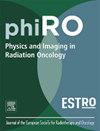Rectal-RadioSAM: Large model-assisted multi-parametric magnetic resonance imaging pipeline for predicting response to neoadjuvant chemoradiotherapy in rectal cancer without human intervention
IF 3.3
Q2 ONCOLOGY
引用次数: 0
Abstract
Background and purpose
Accurate evaluation of response to neoadjuvant chemoradiotherapy (nCRT) in rectal cancer is critical for guiding clinical decision-making. This study developed and validated a large model-assisted automated prediction tool to assess response to nCRT in locally advanced rectal cancer (LARC), focusing on segmentation and radiomic feature extraction.
Material and methods
A retrospective analysis included 378 LARC patients (756 cases: baseline and post-nCRT MRI). MRI protocols comprised T2-weighted imaging (T2WI) and logarithmic diffusion-weighted imaging (DWI, b = 1000 s/mm2). A two-stage hybrid model combined fine-tuned four-channel MedSAM networks for lesion segmentation and a coupled XGBoost model for pathologic complete response (pCR) prediction. Resilience of radiomic features was assessed by comparing automated and manual segmentations.
Results
In the independent testing set comprising 112 LARC patients, the large segmentation models achieved mean (± std) Dice coefficients of 0.74 (± 0.09), 0.66 (± 0.13), 0.67 (± 0.15), and 0.46 (± 0.15) for pre-nCRT T2WI, post-nCRT T2WI, pre-nCRT DWI (log[S(1000)]), and post-nCRT DWI (log[S(1000)]) images, respectively. Meanwhile, First-Order and Shape radiomic features exhibited significant correlations between the large model-assisted segmentations and manual delineations (p < 0.01). In the prediction phase, the combined pipeline achieved a mean (± std) AUC value of 0.83 (± 0.04).
Conclusion
The large model-assisted multi-parametric MRI pipeline demonstrated robust performance in predicting pCR for rectal cancer, enabling fully automated radiological assessment without human intervention.

recal - radiosam:大型模型辅助的多参数磁共振成像管道,用于预测无需人为干预的直肠癌新辅助放化疗的反应
背景与目的准确评价直肠癌患者对新辅助放化疗(nCRT)的反应对指导临床决策至关重要。本研究开发并验证了一个大型模型辅助自动预测工具,以评估局部晚期直肠癌(LARC)对nCRT的反应,重点是分割和放射学特征提取。材料与方法回顾性分析了378例LARC患者(756例:基线和ncrt后MRI)。MRI方案包括t2加权成像(T2WI)和对数扩散加权成像(DWI, b = 1000 s/mm2)。两阶段混合模型结合了用于病灶分割的微调四通道MedSAM网络和用于病理完全反应(pCR)预测的耦合XGBoost模型。通过比较自动和手动分割来评估放射学特征的弹性。结果在包含112例LARC患者的独立测试集中,大分割模型对ncrt前T2WI、ncrt后T2WI、ncrt前DWI (log[S(1000)])和ncrt后DWI (log[S(1000)])图像的平均(±std) Dice系数分别为0.74(±0.09)、0.66(±0.13)、0.67(±0.15)和0.46(±0.15)。与此同时,一阶和形状放射特征在大模型辅助分割和人工圈定之间表现出显著的相关性(p <;0.01)。在预测阶段,联合管道的平均(±std) AUC值为0.83(±0.04)。结论:大型模型辅助的多参数MRI管道在预测直肠癌pCR方面表现出强大的性能,可以在没有人为干预的情况下实现全自动放射评估。
本文章由计算机程序翻译,如有差异,请以英文原文为准。
求助全文
约1分钟内获得全文
求助全文
来源期刊

Physics and Imaging in Radiation Oncology
Physics and Astronomy-Radiation
CiteScore
5.30
自引率
18.90%
发文量
93
审稿时长
6 weeks
 求助内容:
求助内容: 应助结果提醒方式:
应助结果提醒方式:


